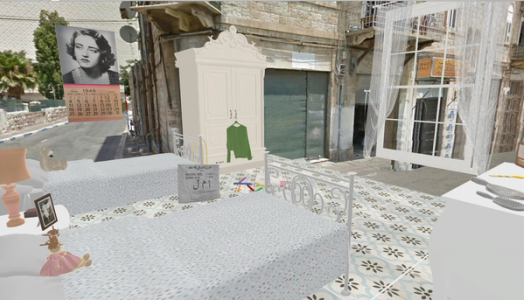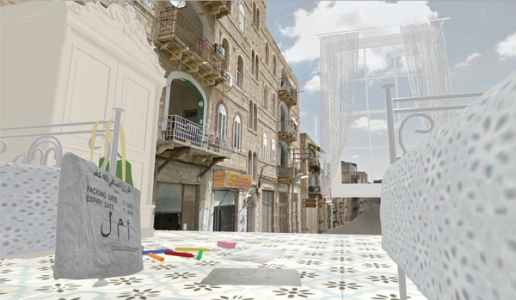
Solénne Tadros
PRE-EXODUS, 2018
Virtual Reality Simulation on the Oculus Go.
A virtual exhibit by Solénne Tadros gently unveils the tragic tale of her grandmother Leila and the bedroom she shared with her sister in Haifa, Palestine.
The VR experiment depicts a bedroom frozen in time from when Leila was 13, showing the space exactly as it was prior to her being forcibly displaced along with her family by a quasi-military body representing the Jewish community and Zionist movement, during the Nakba in 1948.
Left with just a few hours to pack their belongings before getting on the last boat leaving Haifa, Leila and her sister fled with two suitcases each, and mindfuls of childhood memories. Today, Leila (now 92) lives in Amman, Jordan and her Haifa is a very different city – most olive trees are replaced with pine, and it is a challenge to trace the history of Palestinian homes and buildings.
And so Tadros recreated her grandmother Leila’s narrated descriptions of that lost childhood bedroom into a virtual-reality experience. Her vision was to form a digital representation of what was left behind, and capture that which was deeply etched in Leila’s memory. In 3D, the viewer is uncomfortably and intimately enshrined within what Leila ultimately had stolen from her.
Tadros says that bringing people into the recreation of her grandmother’s childhood bedroom was one way to get people to connect to not only Leila’s story, but the story of Palestinians. For Tadros, this was her opportunity to bring a human side to a narrative often overshadowed by political discourse.
'It was crazy to me how photographic her memory was, so it was pretty easy for me to translate it into a VR experience. Technologically, I was still so new to the medium, though, so that was my challenge. The reason I focused on the bedroom is to show others that behind the word ‘refugee’ is a person and a life. My grandmother and her sister had a childhood just like you, just like me.'

The foundation of the VR image is a 360-degree image taken from Google maps of Leila’s old neighbourhood in Haifa, from which she then digitally removed traces of objects built since the Occupation.
A calendar for 1948 hangs in the virtual room to time travel the viewers back to the moment. The calendar features an image of Asmahan, a famous singer Leila would listen to as a child, while one of her songs "Layali Al Ons" plays in the background. The title translates to "Nights of Merriment" in English.
The VR experience shows coloured childhood crayons and papers on the floor as they were left by Leila, an artistic child. It is layered with illustrations drawn by displaced Syrians now settled in Jordan. Each drawing spells out the word “hope” in Arabic.
Tadros talks of the dance between hesitation and courage that preceded sharing her virtual reality masterpiece with her grandmother. So much rested on her approval. She was concerned that her creation might not align with her grandmother's memories. She waited three years to muster the courage to finally share the creation with Leila and was ultimately able to gift a small splinter of her lost life back to her.
Tadros felt in her bones that it was right to persist. “I was just scared that if I showed her something it would stir up tension in her. I didn’t want to hurt her, for her to have a heart attack! On the other hand, I was scared as an artist, as a creator, that she wouldn’t recognise anything.” But she described her grandmother’s memory as impeccable.
The emotional moment unfolded as Leila went into the virtual room and was transported via technology back in time. “I didn’t have the guts to show it to her until 2021. Every single time she would speak about her story she’d tear up or struggle. She’d say, ‘I don't talk about this any more.’”
'When I did finally show it to her, she was like, ‘Oh my god, the balconies. Oh my god, the beds.’ When she took the VR set off, she told me it was like a dream to be back in Palestine. That’s what I wanted. It was so much more difficult for her because she knew what Palestine was like, she knew what her bedroom was like. As a creator, to think I could even remotely recreate Palestine was naive. It was a big goal.'

The artist cautions against the assumption that the VR experience she has created is the truth, citing instances where narratives constructed by outsiders will continue to change it. In her quest for justice and awareness, she challenges the West to question any narrative it is presented, and incites the power of VR to instigate a shift in how stories are told so that people might question the beliefs they are fed and be able to put themselves in the shoes of others. Tadros’ pixelated afterlife of a displaced homeland becomes digitally pressed into the viewer's heart and mind.
Tadros grew up in Jordan, “with all the chaos happening around me. It was the norm for Lebanon to be on fire, Palestine to be on fire, Iraq to be on fire, and Syria. This was the norm for me, but I still knew that they were my people. I still knew that they were just like me,” she says. Later she travelled abroad and to New York, to study at Parsons School of Design there.
'Anyone from the Middle East was stereotyped as barbaric. They were so shocked that I was an Arab Christian coming to study in New York who spoke English fluently. They didn’t know that there was anyone like that; they didn’t know I existed, even though there are so many people like me.'
Today, Tadros’ project has made its way around the world. “As a VR project, not many people are familiar with the technology, but some people who come to the exhibition leave with tears in their eyes.”

Solénne Tadros is an artist who works with technology and digital design to convey her and her ancestors’ stories and messages. Her focus often returns to technology and its effects, as well as to refugee crises and the injustice of human displacement. She uses her art, her platform, and her technological abilities to raise awareness of and support those who have been displaced. Her creative use of immersive technology preserves and humanises memories of Palestine.
Interview by Cat Crawford and Lucy Kumara Moore
Article by Melissa Gilmour and Lily Hill
Edited by Alexandra Pereira